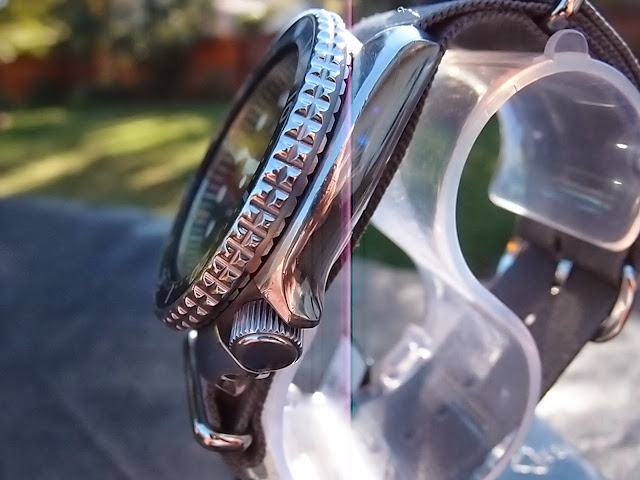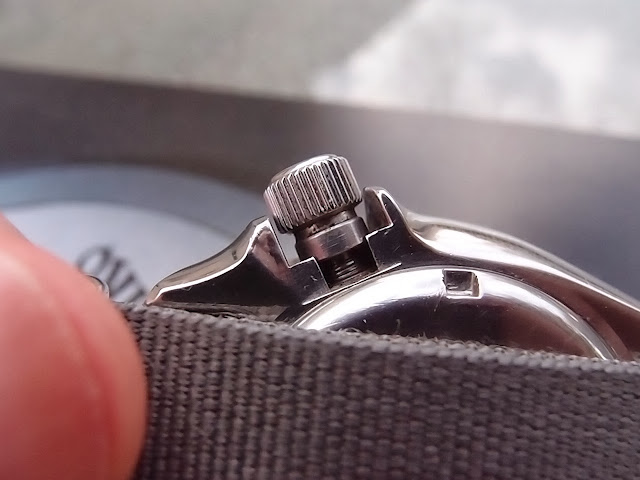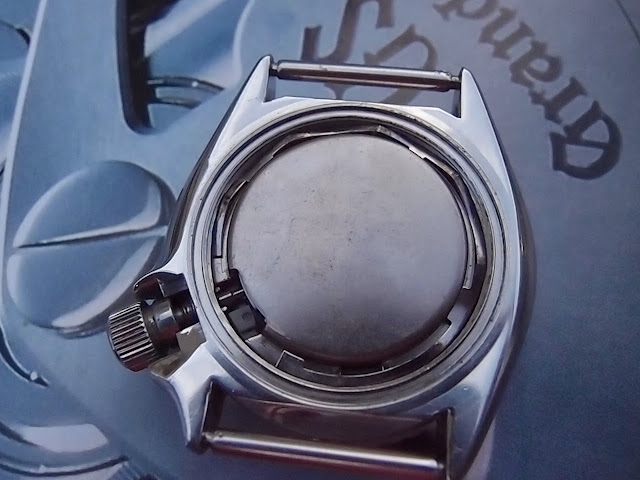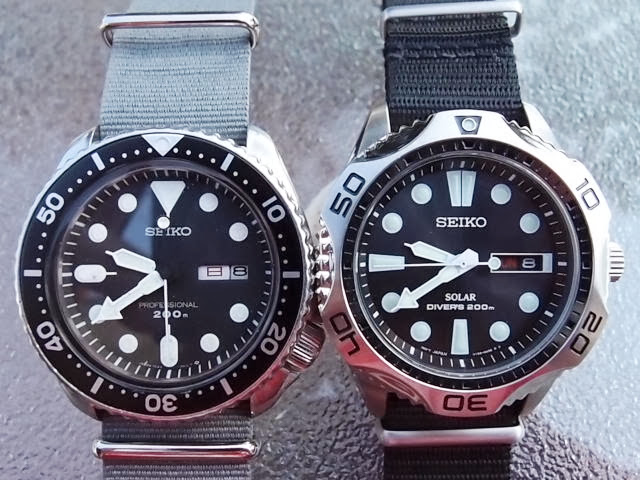When it comes to current quartz professional divers from Seiko, you’re options are limited. Aside from the Tuna models, there seems to be a plethora of low budget Seiko quartz divers with uninspiring movements and each one seems to have some some kind of instantly polarizing quirky feature and not the traditional, clean, classic Seiko diver DNA. For the longest time I had hopes that Seiko would eventually introduce a classic, quartz professional diver, but I have since given up.
I've never really had much interest in vintage pieces. I recognize the history and importance of a select few models, I never had much interest in restoration projects and often times the price of mint examples far exceeds their value to me. But there comes a time when you just have to accept that the vintage models may be your best bet in finding what you are truly interested in and just be willing to accept some wear and tear or simple restoration activities.
Quartz actually makes a good option for collecting vintage. Although movement parts may be hard to come by, repair is a lot less likely than for mechanicals. The most likely fate for vintage quartz is the battery dies and the owner tosses the watch into a drawer not to be seen again for many years. The greatest risk to vintage quartz is the damage from a leaking battery which if that is encountered, you’re likely toast. So if you have your own collection of quartz watches sitting in a drawer, its best to just remove the dead battery, even if you don’t intend on replacing it at the moment. If you happen to buy a vintage quartz, be sure to open it up and check the battery. If it happens to be a no-name brand, just toss it and replace it with a fresh battery from a recognizable brand as its not worth saving a few dollars at the unnecessary risk of frying your vintage quartz watch with leaking battery acid.
So that brings the focus to two calibers….7548 and 7C43. The 7548 has a good history as a jeweled, high torque quartz movement that ran in parallel with the ever popular 6309 calibered divers. In fact the 7548 is a perfect drop into a 6309 case to make the best of both worlds. The 7548 models are still plentiful to this day as they had a fairly long production run and favor from the benefit of fitting all the exterior parts to that of the 6309 divers so parts are a plenty.
The 7C43 is an evolved 7548. Similar to the 7548 is is also a high torque, jeweled (7) quartz movement. The high torque permits for the use of the heavier hands typically used in mechanical calibers. The trimmer regulation of the 7C43 differs from that of the 7548 in that instead of the traditional trimmer screw that is used in the 7548, the 7C43 uses an alteration in the circuitry which results in a one time use, irreversible change of either + or - 0.2 seconds per day. The 7C43 takes a SR927SW battery for an expected life of 3 years. If your’s burns through batteries quicker, it most likely needs a movement service as the internal circuit pulls more power from the battery in order to overcome the increased gear train friction from old oils.
The 7C43 makes a notable entry in the Tokunaga Watch Museum with the following entry:
No.010 Professional 200m diver's watch
(Analog quartz movement : 7C43)
Expand Commercialization: in 1986
Feature:
The best-seller professional 200m diver's watch model which attained the performance in 200m saturation diving. The movement is [7C43] which has the same performance as that of [7C46] and smaller size, and magnetic-resistant ability with the high reliability of higher output torque. Although the case structure is a standard type two-piece case (with screw case back) specification, there are 15 new technologies in this case such as; the powerful glass screw ring fixed structure same as 600m with the same glass fixing structure, L shaped glass gasket structure, glass screw ring fixing structure, twin side shield crown structure, special elastic strap made from polyurethane rubber of SEIKO original strap.
This description indicates what puts the 7C43 above many other Seiko quartz divers outside of the Tuna series is the anti-magnetic shield and the crystal retaining ring with the L shaped gasket.
From what I have read online, the 7C43 shares many parts with the 7C46 which is found in the Tuna models. The only difference I have noticed is the 7C46 uses a larger battery and subsequently has a longer battery life than the 7C43. I don't really understand why Seiko would make two nearly identical niche calibers, but I guess that may be explained by the relatively short life of the 7C43.
There seems to be several variants of the 7C43 which differ by dial and insert.
The 7C43-7000 seems to be a North American and/or International model and can be easily identified by the use of “QUARTZ” and “SQ” markings on the dial with the Suwa symbol on the edge by 3 o’clock. Not my picture.
The 7C43-7009 seems to be the Pepsi version of the 7C43-7000. There’s also another Pepsi model 7C43-700A and I can’t tell the difference from the 7009. Not my pictures either.
It can also be confusing as Seiko used two different bezel constructions for some of these models with older builds using the old school bi-directional bezel with a click ball. Earlier examples seem to have transitioned to the uni-directional bezel with click spring which is commonly used on today’s Seiko divers. In addition, I’ve also seen 7C43-7010 dials with the “QUARTZ” marking under SEIKO. I’m sure there are other variations, so don’t consider my list to be exhaustive.
The 7C43 was also used in a series of mid-sized divers which can be identified by case numbers in the 6xxx series and smaller, different looking hands.
I bought this 7C43-7010 from one of the forums. Its in pretty good shape. Case is a little overpolished, but the dial and hands look good for their age. Movement seems to run fine too.
My favorite feature of the 7C43 divers is the use of white trimmed hands with blacked out centers. Aside from providing great legibility, the hands also appear to float above the dial for a cool appearance. The index markers were shared between the 7548 and 7C43 and are indistinguishable from the current SKX007. The dials, however, are not interchangable between the 7548 and the 7C43 are not interchangable as the dial feet are located in different positions.
The case on the 7C43-7xxx models are indistinguishible from the 7548 and the slim cased 6309-729x models. The case does differ from the SKX007 in the position of the 4 o’clock crown on the older models versus the 3:45 crown on the SKX007. I don’t know what functional consequence of the subtle difference in crown location is, but aesthetically, the use of the 4 o’clock crown results in a fatter lower right lug such that the crown guard looks more like an extension of the case rather than a well defined crown guard.
The bezel on this example is a 60 click, bi-directional style. There is a bezel gasket which was easily replaced. The bezel insert is the basic aluminum coated that seems to be the same on all the 7548 and 6309 divers. The case has a spring and click ball at the 2 o’clock lug area. Mine are obviously not original, but seem to work OK. Getting that little ball set into the case like the original is a mystery to me, so this is gonna have to be the way it is. I’ll just be happy not to lose it because the bezel does pop off much easier than any modern diver I've had.
Speaking of popping off the bezel. Do so and underneath you will see the crystal retaining ring. Doesn’t look like much, really. I decided to leave that one alone.
The caseback has the basic Tsunami logo with the battery change stamp on the perimeter. The caseback gasket on mine was missing so a replacement went in its place easy enough. The gasket on this model is positioned on the case itself and not the threads of the cover as is more common on the current models. I found the location on the 7C43 to be a little easier to work with in avoiding a pinched gasket.
Like the other case parts, the crown looks indistinguishable from the 7548 and 6309 models with the crown attached to that collar. The set up of the stem is also similar with the stem attached to the crown through the spring and washer connection. The threaded part of the stem also connects to the interior of the crown through a few threads. Removal required a few heat cycles to break the thread locker. Complete disassembly of the stem parts was necessary to replace the crown gasket, which proved to be a lot more challenging than I expected. I used a safety pin to poke and pull out the old gasket. I then greased the replacement with some silicone and then pushed all the way into the interior of the crown. The gasket was then seated by slowly pulling the gasket out of the crown until it found its proper location. I applied a small amount of blue thread locker to the stem and reapplied into the crown. Lastly, I used a dab of silicone to hold the washer in place on the stem spring then pushed the other end of the stem into the spring at the correct orientation to get it all to fit properly.
Removal of the caseback shows a metal interior. This is one half of the anti-magnetic shield and it simply lifts out of place to reveal the movement underneath. There is another side to the anti-magnetic shield located under the dial, but I had no reason to inspect that part so I’ll assume its still there.
There’s not much to say about the movement. Battery replacements are a breeze because the anti-magnetic shield actually serves as the battery retaining cover which gets squeezed down with the tightening of the caseback.
The crown removal lever took me forever to find. It is not marked and it is very tiny and deeper than I expected. It is located in the semi-circle cut out at the edge of the movement near the crown stem and operates by keeping the crown in a neutral position then pushing down into the hole. If you pull the crown out, then the lever disappears. Get it right, and the crown slides right out, then you can tip the movement out as well. Give the interior of the glass a good wipe with some alcohol and a puff of canned air to blow out the dust. The chapter ring remains attached under the crystal, but it does rotate. Proper alignment with the dial is ensured by a key registration with the movement so pay attention when replacing the movement to make sure it is lined up correctly.
If you are interested in a movement breakdown of the 7C43 click HERE.
That’s about it folks. If you’re like me and not all that interested in mechanical watches anymore, then give some of these old Seiko quartz divers a try. Here’s a picture of the 7C43 along side the modern SNE107. I have to say that the Seiko DNA is very obvious in the SNE107. If the SNE107 had a regular Seiko diver bezel, it would be a classic. As it is now with its scalloped bezel, it is instantly polarizing which is a shame because movement differences aside, the construction of the case and bezel is definitely competitive with the vintage model, if not superior.
7C43-7010 Dimensions (just for perspective, not part replacement!)
Crystal 31mm
Bezel 41mm
Case 42mm
Case with crown 46mm
Lug width 22mm
Lug to lug 45mm
Thickness 12mm
The crown removal lever took me forever to find. It is not marked and it is very tiny and deeper than I expected. It is located in the semi-circle cut out at the edge of the movement near the crown stem and operates by keeping the crown in a neutral position then pushing down into the hole. If you pull the crown out, then the lever disappears. Get it right, and the crown slides right out, then you can tip the movement out as well. Give the interior of the glass a good wipe with some alcohol and a puff of canned air to blow out the dust. The chapter ring remains attached under the crystal, but it does rotate. Proper alignment with the dial is ensured by a key registration with the movement so pay attention when replacing the movement to make sure it is lined up correctly.
If you are interested in a movement breakdown of the 7C43 click HERE.
That’s about it folks. If you’re like me and not all that interested in mechanical watches anymore, then give some of these old Seiko quartz divers a try. Here’s a picture of the 7C43 along side the modern SNE107. I have to say that the Seiko DNA is very obvious in the SNE107. If the SNE107 had a regular Seiko diver bezel, it would be a classic. As it is now with its scalloped bezel, it is instantly polarizing which is a shame because movement differences aside, the construction of the case and bezel is definitely competitive with the vintage model, if not superior.
7C43-7010 Dimensions (just for perspective, not part replacement!)
Crystal 31mm
Bezel 41mm
Case 42mm
Case with crown 46mm
Lug width 22mm
Lug to lug 45mm
Thickness 12mm













































No comments:
Post a Comment